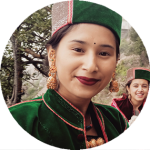
Chulli – The Sour-Sweet Wild Apricot of Kinnaur
Storyteller: Isha Dames
Meeru, Kinnaur District, Himachal Pradesh
September 2023
Read this story in Hindi
Early one Sunday morning, my mother came to my room and called out-
“Ishu, haasal saarash, chool thomo biyomo.” (Ishu, wake up quickly, we have to go collect chulli).
I got up quickly and started preparing shil (lunch or dinner) to take along. After eating breakfast together, my whole family left home to go to the farm, which is a little far from our home. On the way, I got a call from my friend. My friend and I had a lot to catch up on since we were talking after a long. During our chat, I informed my friend that I was on my way to our farm to pick up chulli.
“What is chulli?” she asked curiously.
Since the place to which she belongs doesn’t grow chulli, it was difficult for her to understand what it means. “Chulli is a traditional fruit of Kinnaur that is similar to Khumani (another variety of apricot). Khumani is sweet, whereas Chulli is sour-sweet. Chulli and Khumani trees are similar too. You can eat them as a fruit or enjoy them as dry fruit. In our local Kinnauri language, chulli is called chool. We Kinnaurs believe that one chulli is equivalent to 20 medicines!”
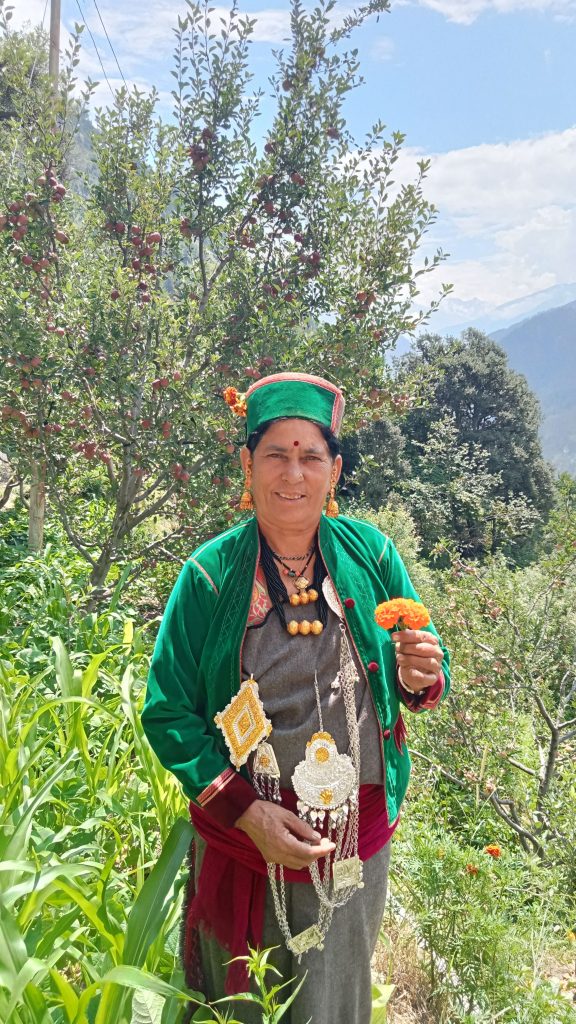
My friend then asked-
“Can I get a chulli plant so that I too can eat the fruit?”
I was pleased about her eagerness to taste the fruit. I explained to her that Chulli is a wild plant that grows on its own. It doesn’t need any fertilizer or special care like many other fruit trees. It is a gift of nature. After a bit more talking, we ended the conversation as I reached our fields.
At the farm, some overripe chullies had already fallen to the ground. But many were still on the trees. My father said-
“You all take some rest. I’ll shake the tree trunks and branches so that the ripe chullies fall off the trees. We can then collect those together.”
My father started shaking the tree trunks and branches and I began collecting the chullies. I ate many of the clean ones too! The chulli-picking exercise brought back memories of my childhood when we would sneak into people’s farms on our way to school to steal chullies and eat them.
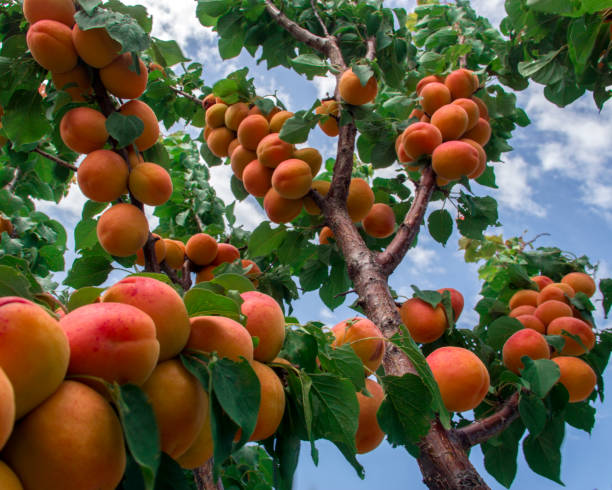
I was still lost in my childhood memories when my mother’s voice broke my reverie.
“Jira Ishu, chool thomo!” (Come, Ishu, let’s pick chulli!)
I got back to collecting chulli – a task that’s rather boring for me! To overcome the boredom and engage my mind, I thought why not ask Aapi (grandmother) to sing a song? To my delight, Aapi willingly obliged and started singing.
“Korimang ee ma gyolisho li chhechchung chau korimang
Jorimaining mau kilimo li sheemig aaeedhu kimo
Aamasta rinangyosha aang chime aang jiva
Prayo beemig haalicho li ju chhechchang chu korimang”
(The lyrics of this Kinnauri song mean that no one should have a fate like girls, who take birth in their homes and die in someone else’s. The mother says my daughter is a piece of my heart, yet it is the fate of girls to go to someone else’s home.)
Not only did Aapi sing the song at my request, she and I chatted a lot too. The day just flew by in chit-chatting and working together. By evening, we had collected a lot of chullies. We distributed those among ourselves and brought them home.
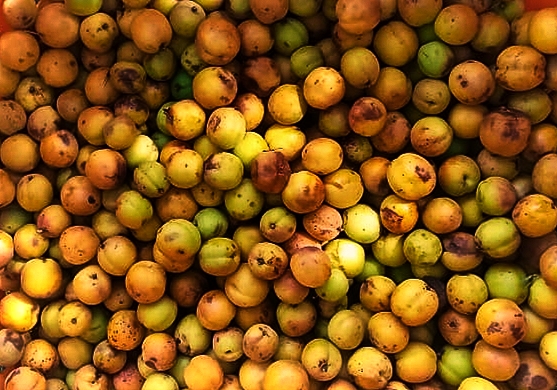
At home, my mother started drying the chullies we had brought along. Everyone else was tired so they freshened up and went to rest. I quickly started preparing dinner so that we all could eat on time and I could call it a day.
Two-three days later, when the chullies had completely dried, I asked my mother to make chool phanting. It had been a long since I last had eaten it and I was craving for it! Chool phanting is a traditional Kinnauri dish made from chulli. (Chulli means apricot and phanting means khichadi). As a kid, whenever I used to eat unripe chulli, it would end up giving me a stomach-ache. My mother would then make chool phanting for me. Our elders believe that chool phanting helps cure many ailments. My tete (grandfather) and aapi say that chool phanting cures stomach-aches and the cold, maintains the digestive power of the stomach and balances the body temperature. It is also believed to increase strength and help focus the mind.
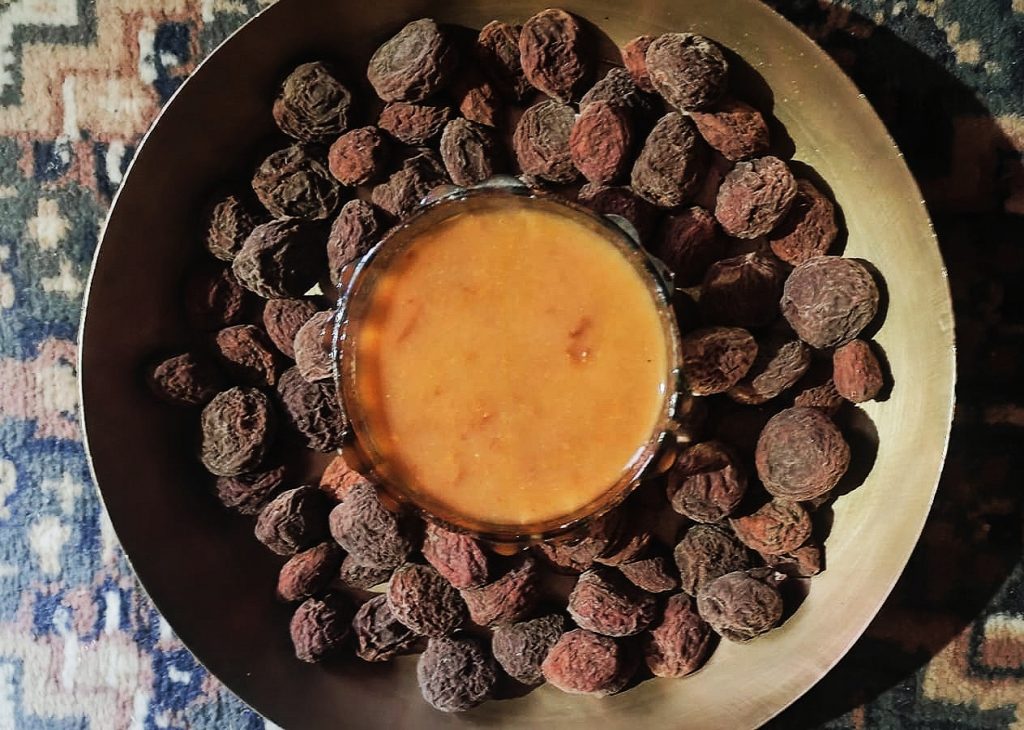
I helped my mother make chool phanting and learnt how to make it alongside. My mother first soaked the dried chullies overnight. She then mashed the soaked chullies to make lafi (a paste) and separated any lumps and kernels from it. After making the lafi, she added koda (raagi/finger millet) flour and brought the mixture to a boil, and the dish was ready to be served. Our entire family relished the phanting together. The dish is delicious by itself, but eating it together with the family made it taste even better.
The kernel of the gutti (seed of wild apricots) that are extracted from the chulli is also beneficial for health. A famous local dish made from gutties kernels is called remo-kan. My grandma and grandpa love remo-kan. Remo means gutti and kan means sabzi/curry. To make remo-kan, the gutti kernels are crushed and made into lafi. My grandma says, the more bitter the gutti kernels, the tastier the remo-kan. The lafi is then boiled thoroughly until its bitterness is gone. Then, chopped green vegetables are added to the mix.
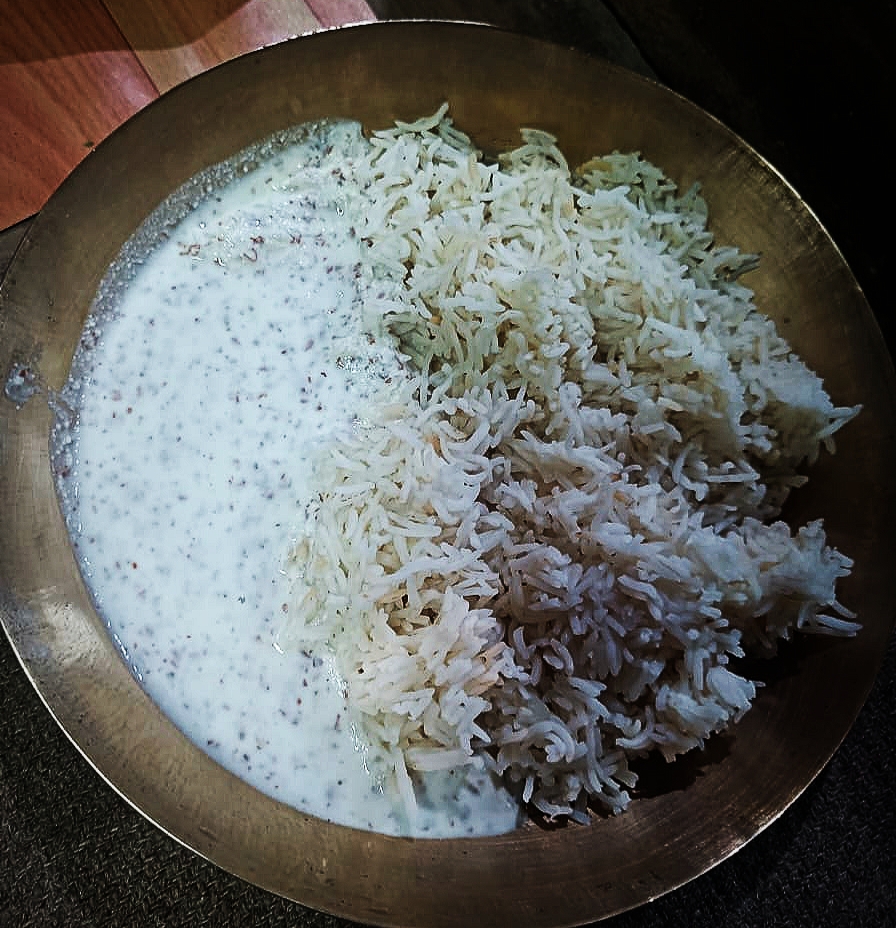
I once prepared remo-kan and fed it to my mother and grandma and I ate too! While eating it, my grandmother told me that remo-kan warms the body and also has other useful qualities. We usually eat it with rice or roti (flat bread).
Chulli gutti kernels are also used to extract oil. One day, I was craving to eat sattu (roasted barley flour). I went to the kitchen and started looking for sattu and chulli oil in the cupboard. I found the sattu, but couldn’t find chulli oil. When aapi entered the kitchen, I asked her-
“Aapi, chool telang haam toh?” (Grandma, where is chulli oil?)
Aapi responded-
“Yug storo neeto thara g kartok.” (It should be there in the store below. Wait, I’ll bring it.)
And off she went to the store. Despite her age, Aapi doesn’t have any problems going up and down the stairs. She works a lot on the farm too. Her eyes and knees are absolutely healthy. While my grandma was gone to fetch the oil, I prepared the sweet tea. We then called my mother, who was busy doing some work and all three of us had sattu and sweet tea together. We Kinnauri people add chulli oil to sattu and have it with sweet or salty tea with great relish.
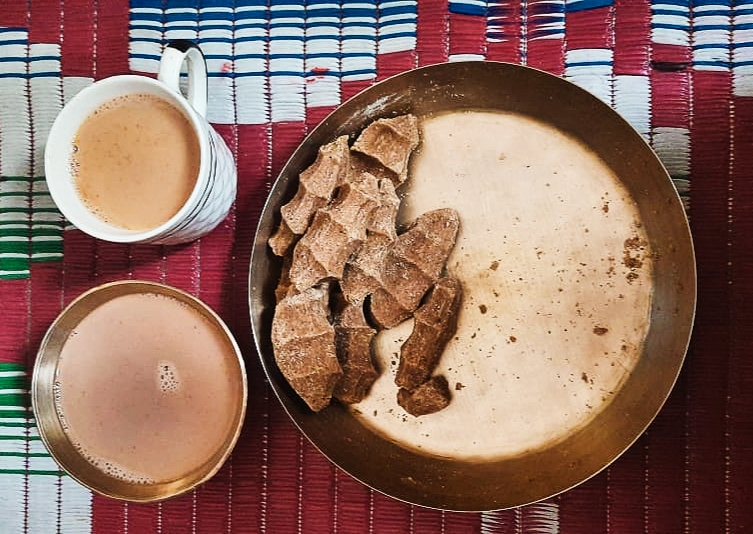
Kinnauri people consider chulli oil massage to be very good because it is said to strengthen the body. We believe that drinking chulli oil also improves eyesight. Chulli oil is believed to cure constipation and joint pain and is considered good for the heart, skin, and hair as well. Whenever Aapi gets tired after working, I give her a massage in the night with this oil, which rids her off her tiredness and relaxes her. Chulli oil has also been granted the GI tag by the Government of India.
I often help my mother to extract gutti from chulli. Mother breaks the seed with a stone and I pick the gutti kernels from the broken shell. Mother says that in olden times, oil used to be extracted by grinding gutti kernels in a kaning (traditional okhli or mortar and pestle). Extracting oil this way ensured that the quality of the oil remained intact. Extracting oil using a kaning is a difficult task though. Nowadays, we have convenient alternatives– we can use machines for oil extraction. But according to my mother, the nutritional value of oil extracted using machines is less than the oil extracted using the kaning.
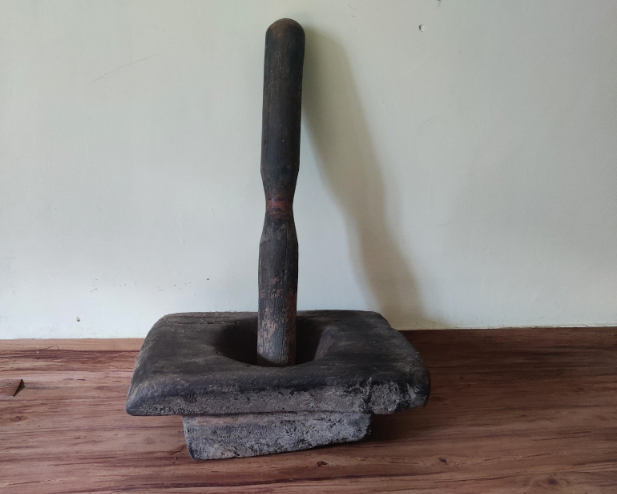
Since my childhood, I have seen my mother make chool-muri (country liquor) in the months of June-July, which is the season of chulli harvesting. Chool-muri is also used as a cure for cough and cold. As you can see, every part of the chulli is useful. No part of it goes waste. The shell of the chulli from which the gutti is extracted is used for burning a fire.
We, the people of Kinnaur, also make traditional garlands from chulli gutti kernels, that are used on weddings and other happy occasions.
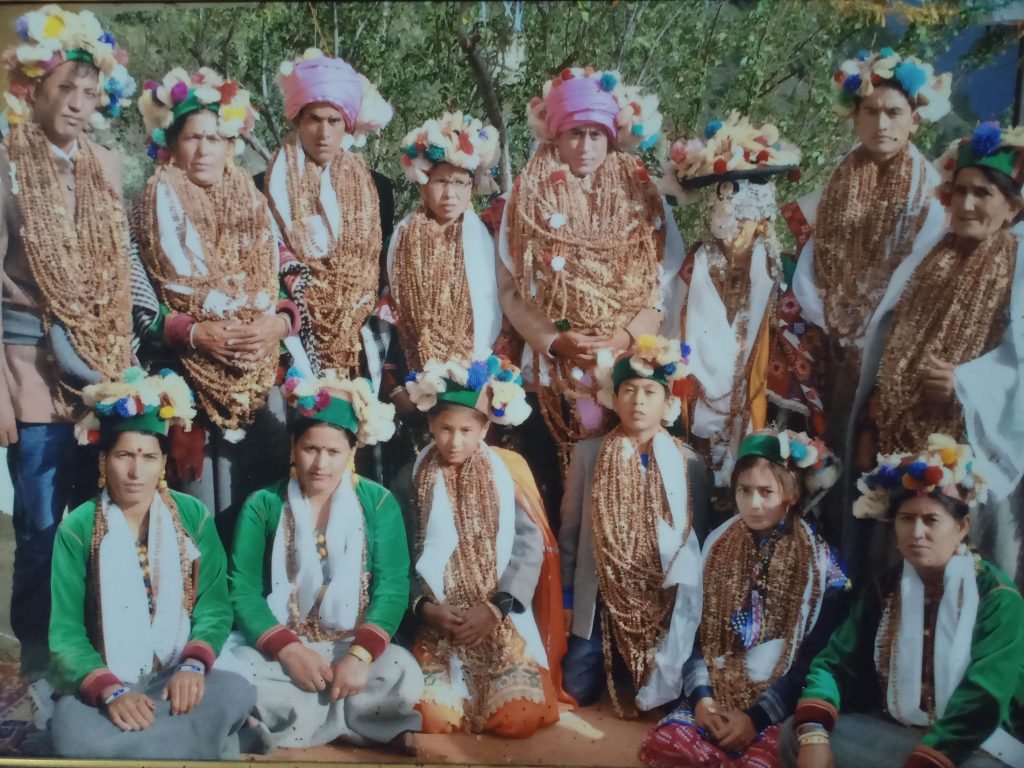
(I am seated in the bottom row, third from the left)
On 2nd June 2014, we celebrated my brother’s shu-kud (congratulatory ceremony). The elders in the family pray to the deity and express their wish for the birth of a son or daughter in the family. Shu-kud is the grand congratulatory ceremony organized by the family after the fulfilment of that wish. Kinnauri people have been following this tradition since ancient times and even today people celebrate it with great pomp. I was 11 years old when my brother had his shu-kad and that was the first time I got to know about this custom followed in Kinnaur. My relatives and people from the whole village had gathered at our home for the celebration. After feasting on the food and dancing and singing the whole day, my entire family got busy applying tika/tilak and offering garlands of chulli gutti kernels to the guests. I was happy to see the celebration. This tradition is unique to Kinnaur and different from other places. It is quite a beautiful experience to be part of.
Probably every person from Kinnaur likes chulli because this fruit is associated with our traditions, our food, and our ways of living. I liked this fruit as a child and I love it even today.
Meet the storyteller



